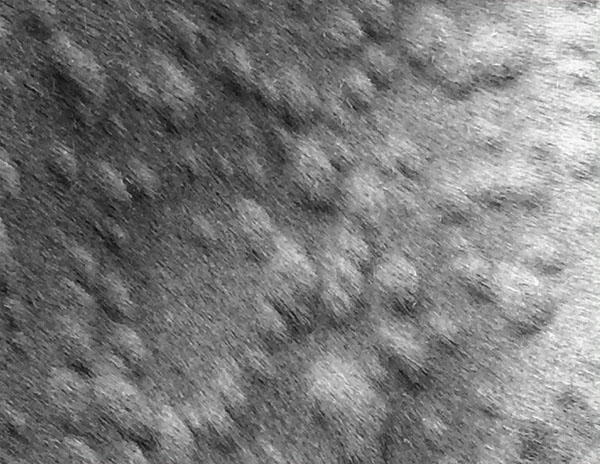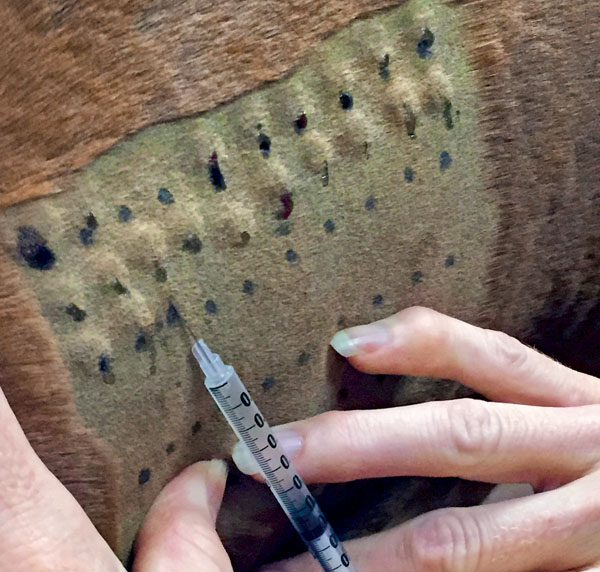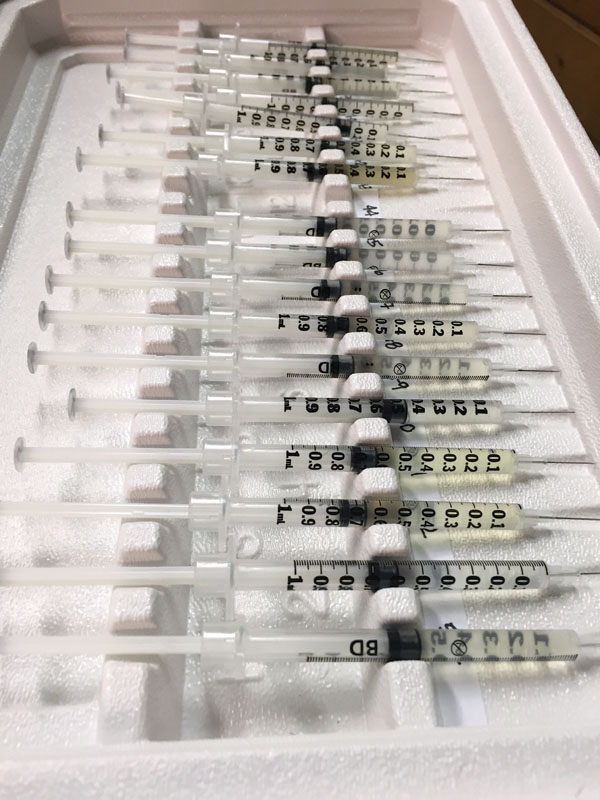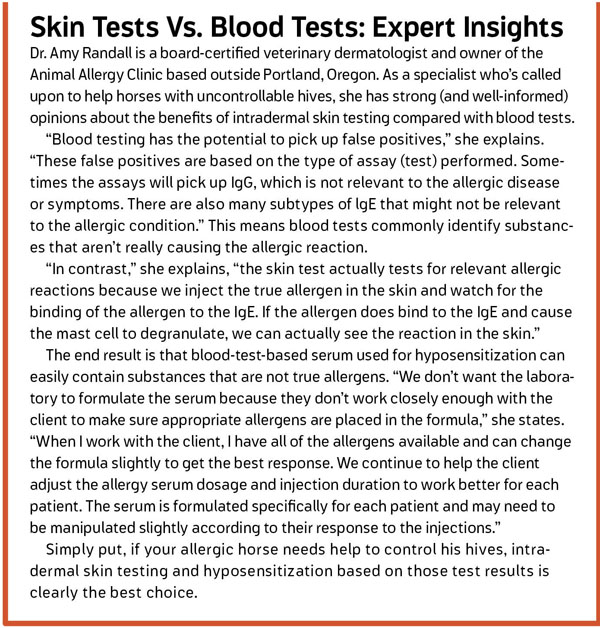You arrive at the barn, and your horse is covered in bumps. “Just give him a dose of dex,” advises your trainer, speaking of dexamethasone, a steroid commonly used to treat skin conditions. “That’ll cure them right away. Hives aren’t a big deal.”

“Oh, no!” exclaims the stable owner. “Steroids like dex are terrible drugs. You should never give them to your horse. Call your veterinarian immediately before this turns into a terrible allergic reaction!”
You’ve never seen a case of hives before. You’re confused. “How could two knowledgeable, trustworthy horse people have such different opinions?” you wonder. “What should I do?”
The answer, of course, lies somewhere in the middle. Just like humans, horses have all kinds of allergies to many different things. Sometimes an allergic reaction can be sudden and severe, while other times it takes its time to cause a wide range of different signs—including a cough, swollen legs, or bumps in the skin that we call hives. And because hives are common, everyone has an opinion on them.
In this article, I’ll help you navigate the maze of different advice you’ll hear, and arm you with the truth behind the many myths your friends will share. That way when your horse has hives, you’ll know what to do.
Don’t Blame the Bugs
Myth: My horse was swarmed by mosquitos, and now he’s covered in bumps. Poor guy. They bit him all over his neck and shoulders. I think he’s really miserable.

Truth: Many owners see those telltale bumps and attribute them to insect bites when, in reality, they’re hives—the end result of a complicated allergic response. When your horse is exposed to allergens (substances that trigger an allergic reaction), they bind to an antibody called IgE that’s circulating in his blood stream. This IgE that’s been “turned on” then binds to several different types of cells, including mast cells (in his tissues) and eosinophils (in his blood). These cells react by leaking chemicals (including histamine) that then cause small blood vessels to dilate and leak fluid into surrounding tissues. This small accumulation of fluid is what makes the hive.
Hives can have a number of different characteristic appearances—including small bumps under the skin; ring-like raised areas of skin (called wheals); and very large, thick lumps. In some cases, the fluid within the hive will even leak out of the skin, causing scabs and areas of hair loss.
The good news is that hives are rarely dangerous and, surprisingly, they don’t make your horse terribly uncomfortable. In fact, they rarely even itch. Still, if your horse has hives (especially if they’re accompanied by scabs and hair loss), you’d probably like to make them go away eventually. And in a perfect world, you’d make them go away forever!
You Can’t Have Just One
Myth: I think my horse is allergic to the chemicals in my new fly spray. I sprayed him yesterday, and today he’s covered in hives. At least it’ll be easy to solve—I just need to give that bottle away and find a different kind to use.
Truth: If only it could be so simple! Rarely is your horse’s allergy a reaction to just one thing. Instead, allergies typically have a cumulative effect. If yours is an “allergic horse,” he’s likely to be sensitive to a number of different things, some more than others. His body’s reactions to these allergens will add up as he’s exposed to more and more—until he finally reaches a threshold where symptoms appear. This means that, although the fly spray may very well be a contributor, chances are it wasn’t solely responsible for your horse’s hives. It’s more likely it was just the “final straw” that pushed your horse’s allergy response over the threshold level required for him to develop hives.
Why is this significant? Because it means controlling his hives is likely to require more than just eliminating the fly spray from his life. Instead, you’ll need to identify and eliminate a variety of different allergens to keep his hives at bay. Otherwise, his body may well be pushed over that allergic threshold whenever a new allergen that’s “on the list” comes along, and he’ll get hives again.
Don’t Over-Medicate
Myth: Thank goodness dexamethasone is so effective for curing hives. My horse does get them fairly often, but with just few injections, they’re all cured.

Truth
Unfortunately allergies aren’t ever really “cured.” Unless you’re really lucky and your horse experiences an isolated reaction to some specific allergen, a dose of dexamethasone may eliminate the symptoms (hives) for the short term, but chances are they’ll be back. So why can’t you just keep your allergic horse on a steady regimen of dexamethasone? Because this medication can have significant side effects, including immune suppression, liver damage, or—most frightening of all—laminitis.
The best solution to your horse’s hives is to avoid the substances that stimulate the allergic reaction. But that’s not always easy. It’s challenging to identify all of the allergens he’s sensitive to. And it can be impossible to avoid them—especially when the list includes alfalfa, orchard grass, dust, or other things that are everywhere in his environment. Common-sense management changes such as moving him to an outside stall or paddock; sprinkling his hay with water to minimize dust; and making sure he isn’t inside the barn when stalls are being cleaned, aisles swept, or the arena dragged. Of course, if you do identify a specific substance that causes your horse to break out in hives (such as a specific type of hay or shavings), avoid it altogether if you can.
If you’re doing everything possible to control your horse’s environment and he still gets hives, long-term treatment with dexamethasone is a risky solution. Work with your veterinarian to explore some alternative medications to control your horse’s allergies. Some horses respond well to prescription antihistamines such as hydroxyzine or doxepin, or even over-the-counter options like Benedryl or Zyrtec. Others might not respond to antihistamines, but do improve with prednisolone—a corticosteroid that has less risk for side effects than dexamethasone. Sound like a lot of different choices?
Allergies
Allergies in horses are just like allergies in humans. Think about the number of different medications you see when you walk down the allergy aisle at your local pharmacy. Like their human counterparts, every allergic horse responds to medications differently. Consult with your own veterinarian for help to formulate an effective medication plan for your individual horse.
Finally, there are some supplement options that can help keep allergies under control. If your horse gets hives, always include an omega fatty-acid supplement with his daily ration. While it may not eliminate the hives completely, chances are it’ll reduce the amount of medication he’ll need to keep the allergies under control. When selecting a fatty acid supplement, look for one that’s higher in omega-3 and lower in omega-6. Flax seed is a readily available example of a supplement that has the ideal fatty-acid ratio.
Splurge for the Skin Test
Myth: My horse’s hives are seasonal—he gets them every spring. My friend told me I can do a blood test to figure out what’s causing the allergies. It’ll be a relief to know what to avoid in my horse’s lifestyle so the hives stop coming back.

Truth: There’s no question that allergy testing is the best answer for helping you to manage your allergic horse’s hives. But there’s a big question about whether blood testing is the best technique. In fact, most specialists agree that intradermal skin testing is much more accurate and effective.
With a blood test, the lab looks for allergen-specific IgE antibodies and generates a list of things that could contribute to your horse’s allergic response. The list of possible allergens is extensive and often includes substances that are irrelevant to your horse’s lifestyle. From this list, the lab will generate a serum to be used to hyposensitize (desensitize) your horse through a series of allergy shots. While this process is effective for some horses, experts agree it often over-identifies allergens, thus over-treats.
In contrast, intradermal skin testing involves injecting a small amount of different potential allergens into your horse’s skin. A bump will form if the allergens elicit an allergic response. The size of the bump corresponds to the magnitude of your horse’s reaction. The veterinarian carefully selects the allergens to test based on substances in your horse’s environment, so you gain horse-specific information. You’ll learn what substances are most important to avoid, which means the allergens included in your horse’s allergy serum for hyposensitization will be much more relevant and specific.
Get Worse Before Better
Myth: My horse’s hives were really bad, so I started giving him allergy shots. They get his body so used to the things he’s allergic to that he doesn’t react anymore. The only problem is that sometimes his hives get worse right after I give him a shot.
Truth: There’s no doubt about it, allergy shots or hyposensitization are the safest, most effective way to help your seriously allergic horse. But how they actually work is greatly misunderstood. In truth, instead of simply “wearing down” your horse’s immune system so he won’t develop hives when exposed to allergens, this treatment actually shifts his immune system from producing one type of antibody to another. Instead of producing IgE when he’s exposed to allergens, his body produces a different type of antibody called IgG. How does this help? IgG doesn’t have the same effect of binding with eosinophils and mast cells, meaning the substances that produces the allergic symptoms (hives) aren’t released.
Another misconception is that your horse’s hives may worsen in the day or two after you administer the allergy shot. While it’s true his hives may worsen during the early stages of the treatments, once the hyposensitization process has been firmly established, hives should actually improve after he receives an injection. This means that if your horse receives allergy shots yet still breaks out in hives, his hives should improve when he gets a shot. If they don’t, it may be time to re-evaluate the formulation of the allergy serum.

